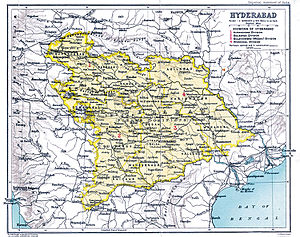
Back عملية بولو Arabic অপারেশন পোলো Bengali/Bangla Operación Polo Spanish Annexion de l'État de Hyderabad par l'Inde French ऑपरेशन पोलो Hindi Operasi Polo ID Operazione Polo Italian ポロ作戦 Japanese 폴로 작전 Korean ഓപ്പറേഷൻ പോളോ Malayalam
| Operation Polo | |||||||
|---|---|---|---|---|---|---|---|
 The State of Hyderabad in 1909 (excluding Berar) | |||||||
| |||||||
| Belligerents | |||||||
|
|
| ||||||
| Commanders and leaders | |||||||
| Strength | |||||||
| 35,000 Indian Armed Forces |
| ||||||
| Casualties and losses | |||||||
| Less than 10 killed[4] | |||||||
The princely state of Hyderabad was annexed by India in September 1948 through a military operation code-named Operation Polo, which was dubbed a "police action".[9][10][11]
At the time of partition of India in 1947, the princely states of India, who in principle had self-government within their territories, were subject to subsidiary alliances with the British, giving them control of their external relations. With the Indian Independence Act 1947, the British abandoned all such alliances, leaving the states with the option of opting for full independence.[12][13] However, by 1948 almost all had acceded to either India or Pakistan. One major exception was that of the wealthiest and most powerful principality, Hyderabad, where the Nizam, Mir Osman Ali Khan, Asaf Jah VII, a Muslim ruler who presided over a largely Hindu population, chose independence and hoped to maintain this with an irregular army.[14]: 224 The Nizam was also beset by the Telangana rebellion, which he was unable to crush.[14]: 224
In November 1947, Hyderabad signed a standstill agreement with the Dominion of India, continuing all previous arrangements except for the stationing of Indian troops in the state. India felt that the establishment of a Communist state in Hyderabad would be a threat to the country.[15][16] Nizam's power had weakened because of the Telangana Rebellion and the rise of a radical militia known as the Razakars whom he could not put down. On 7 September, Jawaharlal Nehru gave ultimatum to Nizam, demanding ban on the Razakars and return of Indian troops to Secunderabad.[17][18][19] India invaded the state by 13 September 1948, following a crippling economic blockade, and multiple attempts at destabilizing the state through railway disruptions, the bombing of government buildings, and raids on border villages.[20][21][3] After the defeat of Razakars, the Nizam signed an instrument of accession, joining India.[22][23]
The operation led to massive violence on communal lines, at times perpetrated by the Indian Army.[24] The Sunderlal Committee, appointed by Indian prime minister Jawaharlal Nehru, concluded that between 30,000–40,000 people had died in total in the state, in a report which was not released until 2013.[6] Other responsible observers estimated the number of deaths to be 200,000 or higher.[7]
- ^ "Press Communique" (PDF). Press Information Bureau of India – Archive. 21 September 1948. Retrieved 16 February 2020.
- ^ "RIAF in Hyderabad" (PDF). Press Information Bureau of India – Archive. 23 September 1948. Retrieved 16 February 2020.
- ^ a b Cite error: The named reference
ShermanLSEwas invoked but never defined (see the help page). - ^ "585 Mohan Guruswany, There once was a Hyderabad". www.india-seminar.com. Retrieved 28 May 2021.
- ^ a b Cite error: The named reference
mohanGuruswamywas invoked but never defined (see the help page). - ^ a b Noorani 2014, Appendix 15: Confidential notes attached to the Sunderlal Committee Report, pp. 372–373
- ^ a b Smith 1950, p. 46.
- ^ Cite error: The named reference
NooraniUntoldwas invoked but never defined (see the help page). - ^ "Hyderabad had tried 'NRC' 71 years ago, and failed". The Times of India. 15 September 2019.
- ^ "Hyderabad Police Action". Indian Army. Retrieved 13 September 2014.
- ^ B. Cohen (2007). Kingship and Colonialism in India's Deccan: 1850–1948. Springer. pp. 159–161. ISBN 978-0-230-60344-8.
- ^ Mehrotra, S.R. (1979). Towards Indias Freedom And Partition. Delhi: Vikash Publishing House. p. 247. Retrieved 17 August 2019.
- ^ See Section 7 (1) (b): "the suzerainty of His Majesty over the Indian States lapses, and with it, all treaties and agreements in force at the date of the passing of this Act between His Majesty and the rulers of Indian States, all functions exercisable by His Majesty at that date with respect to Indian States, all obligations of His Majesty existing at that date towards Indian States or the rulers thereof, and all powers, rights, authority or jurisdiction exercisable by His Majesty at that date in or in relation to Indian States by treaty, grant, usage, sufferance or otherwise."
- ^ a b Barbara D. Metcalf; Thomas R. Metcalf (2006). A Concise History of India (2nd ed.). Cambridge University Press. ISBN 978-0521682251.
- ^ "Delhi felt Razakars, communists a threat to India". Deccan Chronicle. 15 September 2018. Retrieved 4 February 2021.
- ^ Ernst, Waltraud; Pati, Biswamoy (2007). India's Princely States: People, Princes and Colonialism. Routledge. ISBN 978-1-134-11988-2.
- ^ Siddiqi, A. (1960). Pakistan Seeks Security. Longmans, Green, Pakistan Branch. p. 21.
- ^ Benichou, L.D. (2000). From Autocracy to Integration: Political Developments in Hyderabad State, 1938-1948. Orient Longman. p. 231. ISBN 978-81-250-1847-6.
- ^ Desai, V.H. (1990). Vande Mataram to Jana Gana Mana: Saga of Hyderabad Freedom Struggle. Bharatiya Vidya Bhavan. p. 142.
- ^ Sunil Purushotham (20 March 2015). "Internal Violence: The "Police Action" in Hyderabad". Comparative Studies in Society and History. 57 (2). Cambridge University Press: 439. doi:10.1017/S0010417515000092. JSTOR 43908352. S2CID 145147551. Retrieved 13 July 2022.
- ^ "New book on Hyderabad's Invasion, 1948's Police Action". The Milli Gazette – Indian Muslims Leading News Source. Retrieved 4 February 2021.
- ^ Chandra, Mukherjee & Mukherjee 2008, p. 96.
- ^ Apparasu, Srinivasa Rao (16 September 2022). "How Hyd merger with Union unfolded". Hindustan Times.
- ^ Cite error: The named reference
BBC Hyderabad 1948was invoked but never defined (see the help page).
© MMXXIII Rich X Search. We shall prevail. All rights reserved. Rich X Search